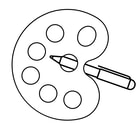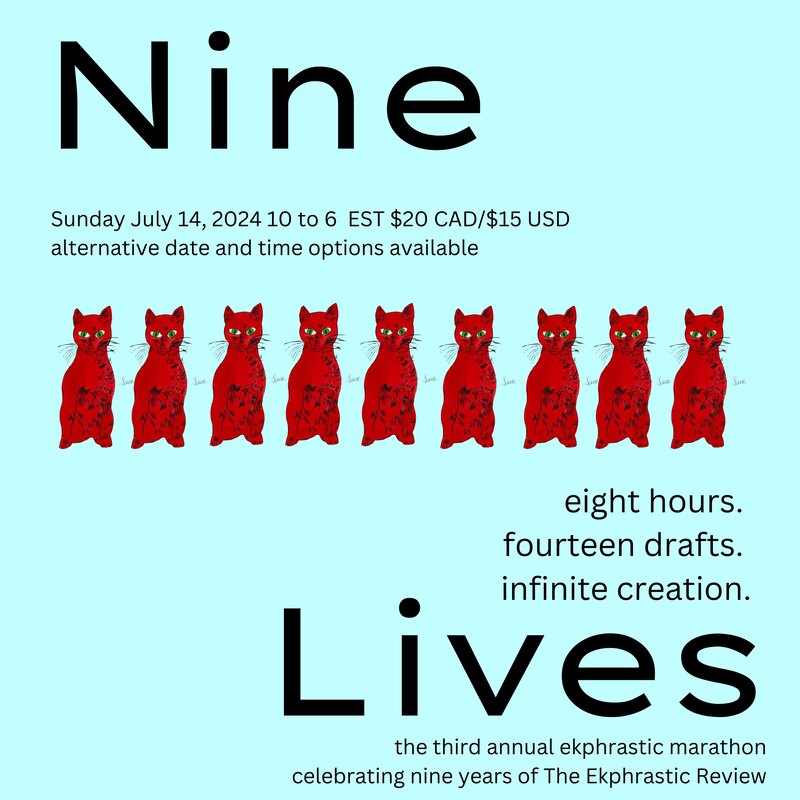|
On Birkenau, by Gerhard Richter During an April in Berlin, when it is still winter, I wear fingerless gloves through a blank white day and take the bus to the Neue Nationalgalerie. Here in the basement of a stark glass building is a Gerhard Richter show: 100 Words for Berlin. The centerpiece of the show is his four Birkenau paintings. The Birkenau pieces are ceiling-height abstractions. Each is slightly different, but they are all executed in grays, reds, whites, greens, their thick paint smeared horizontally and unevenly. The paint is thinly cratered like a moon landscape. The paintings are based on—literally, painted over renditions of—four photographs taken inside Birkenau, the death camp partner to Auschwitz’s concentration camp. Initially Richter attempted to render the photographs figuratively; later, as he came to believe in the impossibility of doing this, he covered them with paint. The photographs were taken by prisoners—the only such photographs of a Nazi camp by victims. It was 1944. * The first time I visited the genocide memorial at Ntarama, the tour guide told me to take photos. We had walked around the site and she had recounted to me the story of Rwanda’s genocide, and now, the way she framed it, I felt she was asking me for something in return. I wasn’t sure: wasn’t it rude, somehow, to take a picture—as if a picture was indeed a taking, as if it was almost embarrassing to photograph these remains? As if violence was somehow shame? I resisted it. Yes, the guide said, moving her hands forward, palms up, in a sweeping motion. At the time—they do not allow this anymore—many tour guides at Rwanda’s memorials were telling visitors to take photographs. Proof of genocide needed to be shared around the world. Too many years of being ignored had taken their toll. Now photographs would prove what had happened here, what had been neglected in 1994 and neglected every year after by outsiders who valued Rwandan lives as little as they plausibly could. As if by witnessing one was returning something to Rwanda: attention, a weak form of reparation. I took a few photographs that first trip: broken windows. Clothing hanging from the ceiling. The same photographs everybody took. The same photographs you would take to rate a visitor attraction. Here is what you’ll see from the outside; here is what you’ll see when you enter. The contents, the clothes, the bones. Here is a close-up at a slight angle. Here you can see the trees. I would hold on to those photographs for years. I was a researcher; I needed them; they made me uneasy, hearts beating in a locked box. * In 1944 in Birkenau, a member of the Sonderkommando, who were responsible for burning bodies from the gas chambers, held the camera. It had been smuggled into the camp by the Polish resistance. The probable photographer was Alberto Errera, a Greek Jewish naval officer. A small team of Sonderkommando members put the exposed film into a toothpaste tube and a woman named Helena Datón smuggled it out. The note that accompanied the photos was from Stanisław Kłodziński, a leader of the camp’s resistance. He wrote: "Sending you snaps from Birkenau – gas poisoning action. These photos show one of the stakes at which bodies were burned, when the crematoria could not manage to burn all the bodies. The bodies in the foreground are waiting to be thrown into the fire. Another picture shows one of the places in the forest, where people are undressing before ‘showering’ – as they were told – and then go to the gas-chambers." When they were first published in the 1940s, the photographs were cropped. In the originals the photos are crooked and slightly blurry, human figures listing to one side. The crops straightened the pictures, aligning them vertically. They made the photographs more straightforward, like journalistic documentation. But they also removed the blackness that had framed each photo. Errera had taken the pictures from a hiding place--the shadowed exit of a gas chamber. In their original form—crooked, unbalanced, half-obscured by the darkness of the building—the pictures are documents not only of events but also of Errera’s towering bravery. I think of Errera hanging back, trusting the interior darkness to hide him. Outside it’s bright—sun on a clearing, pale bodies laid out on the ground before trees—and the photographs are taken at an angle, as if Errera had snapped photos at waist or chest height, unable to check his aim. There is debate about what exactly the photographs depict, based on when they were taken. One narrative says that they were taken within half an hour or even fifteen minutes of each other; another says they depict morning and afternoon. Both arguments are based on the angles of the shadows. Some say they are the before and after of the same transport: people arriving at the gas chambers, being told to undress, heading for the shower, and then, after, the same laid out, dead, in the clearing. Facing Birkenau, I consider Errera taking the first photographs, guarded by several other men; he pointed his camera through the gas chamber’s door, or window, or (one source says) opening through which Zyklon B was poured, knowing exactly what was going to happen, momentarily, to these naked women heading through the trees, toward a spot somewhere to his left. And then after. * A decade ago, for the first time, I stood in front of a room to talk about Rwanda’s genocide memorials. I showed none of those images from Ntarama; none of its bones, or its broken windows. None of its exposed and fleshless human bodies. Someone did ask me why. At the time I thought this choice not to show the dead had to do with shock or respect. I was thinking about the gaze as both witness and violator, of the dead as exposed to view, whether or not they had chosen it. But of course this is an old, old story. Susan Sontag talks about it in Regarding the Pain of Others, her book on the innumerable opportunities a modern life supplies for regarding—at a distance, through the medium of photography—other people's pain. Photography is new, but looking is not. Sontag goes all the way back to a story told by Socrates about Leontius: "On his way up from the Piraeus outside the north wall, he noticed the bodies of some criminals lying on the ground, with the executioner standing by them. He wanted to go and look at them, but at the same time he was disgusted and tried to turn away. He struggled for some time and covered his eyes, but at last the desire was too much for him. Opening his eyes wide, he ran up to the bodies and cried, 'There you are, curse you, feast yourselves on this lovely sight.'" Is it feasting? Something to be eaten and then processed, a consuming witness stuffed with guilt? * Richter reportedly created the Birkenau paintings after a year of attempting to render the photographs figuratively. The art critic Peter Schjeldahl reports that Richter first saw the images in the fifties. … In 2014, he projected them onto canvas and traced them. As he worked, they became illegible. He covered them with paint, layering it on and scraping it away. Now, as Schjeldahl acknowledges, you’d hardly guess, by looking, their awful inspiration. When I visit 100 Words for Berlin, in the same room as Birkenau are images of the original Sonderkommando photographs. The explanation contained in the glossy trifold brochure seems to move the room: the photographs and the paintings slot into place, history stacks around them. I stare at the paintings as if I can see the traces of women’s bodies beneath them: the men standing around the corpses, rummaging as if in a pile of belongings; the smoke rising in great thick billows; the trees stretching up toward the sky. There are two photographs where the walls of the gas chamber are visible, and the corpses of the dead through the opening. A third shows mostly trees and then, down in the bottom left corner, women walking toward their deaths. The fourth aims too high: it shows only branches. What was happening down below them, what Errera saw as he clicked the shutter, is lost. * I passed by the bones at Ntarama and took their picture—but the word took is wrong. I took nothing from them; they felt nothing as I went by; they were still quietly, securely themselves. It was me that felt the churn as the tour guide told me to take a picture, me who sensed them thrumming with blood as they sat quietly in my research folders. The twitching, nervous thing that needed a shield was me—the thing that needed a filter, needed to cover those photographs in paint and color, needed to hide from them. I think of Richter attempting to representing those photographs and then painting over them, scraping the paint off, over and over: sealing them in a box. His process has sometimes been represented as coming to terms with the futility of representation. But it is also a process of protection, a way to admit smallness in the face of something too big to consume at all. The dead are quiet and their photographs equally so. It’s the rest of us who are alive, passing through the rooms of art and death, a roiling, churning set of bodies, turned into what the faces of the silent, judging dead render us: made of what we eat. There’s one more thing Schjeldahl says about Richter’s work on Birkenau. After Richter first saw the Sonderkommando photographs in the 1950s, he encountered them again in 2008 and kept the worst of them hanging in his studio in Cologne. He did not paint Birkenau until 2014. He stared at them for six years. Annalisa Bolin Annalisa Bolin’s writing has appeared or is forthcoming in the Kenyon Review, Tampa Review, the Rumpus, and elsewhere. She is an archaeologist and anthropologist who researches how people perceive and use the heritage of the difficult past, working mainly in Rwanda and the US Virgin Islands.
0 Comments
Your comment will be posted after it is approved.
Leave a Reply. |
The Ekphrastic Review
COOKIES/PRIVACY
This site uses cookies to deliver your best navigation experience this time and next. Continuing here means you consent to cookies. Thank you. Join us on Facebook:
July 2024
|



